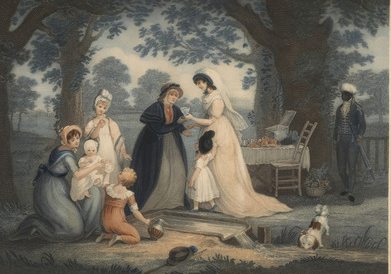Spilsbury does not use picnic (if she even knew the word) to describe the luncheon because it was not yet in everyday use. However, The Drinking Well in Hyde Park (1802) reminds us that the park has long been a popular gathering place for socializing and leisure. Spilsbury makes the scene more pastoral than it probably was because the Drinking Well was in the Ring, an area often crowded with fashionable strollers, especially on Sundays, some with provisions to dine alfresco.
Though Spilsbury’s party has come well provisioned, they kindly purchase water from the matron selling glasses of water. The table shows cakes and fruits. There is a teapot but no means for brewing anything hot, A small boy kneeling beside the fountain holds a glass to a woman holding a baby. Beside the table stands a servant, a dark man wearing a turban and dressed in the livery of an Indian style. He carries an unopened umbrella. The man may be African. In either case, Spilsbury may be acknowledging the plight of Indian and African servants often treated as chattel and enslaved people. If so, is implicit support for the abolition of slavery in the U.K.
Featured Image: James Godby Maria Spilsbury. The Drinking Well in Hyde Park, after Maria Spilsbury 1802) ], hand-colored engraving. London: James Godby (1802). http://collections.britishart.yale.edu/vufind/Record/3640206
See Mrs. Alec Tweedy. Hyde Park: Its History and Romance. London: E. Nash, 1908https://archive.org/details/hydeparkitshisto00twee

